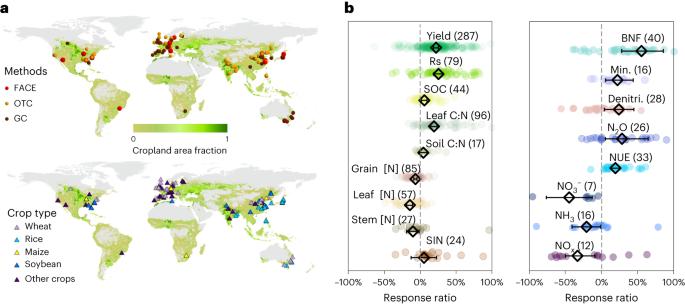Nitrogen cycles in global croplands altered by elevated CO2
IF 25.7
1区 环境科学与生态学
Q1 ENVIRONMENTAL SCIENCES
引用次数: 1
Abstract
Croplands are the foundation of global food security and represent the largest nitrogen flows on Earth. Elevated atmospheric CO2 levels are a key driver of climate change with multiple impacts on food production and environmental sustainability. However, our understanding of how the cropland nitrogen cycle responds to elevated CO2 levels is not well developed. Here we demonstrate that elevated CO2 (eCO2) alone would induce a synergistic intensification of the nitrogen and carbon cycles, promoting nitrogen-use efficiency by 19% (95% confidence interval, 14–26%) and biological nitrogen fixation by 55% (95% confidence interval, 28–85%) in global croplands. This would lead to increased crop nitrogen harvest (+12 Tg yr−1), substantially lower fertilizer input requirements (−34 Tg yr−1) and an overall decline in reactive nitrogen loss (−46 Tg yr−1) under future eCO2 scenarios by 2050. The impact of eCO2 on the altered cropland nitrogen cycle would amount to US$668 bn of societal benefits by avoiding damages to human and ecosystem health. The largest benefits are expected to materialize in China, India, North America and Europe. It is paramount to incorporate the effect of rising CO2 on the nitrogen cycle into state-of-the-art Earth system models to provide robust scientific evidence for policymaking. Current understanding of how the cropland nitrogen cycle will respond to elevated atmospheric CO2 is limited. By modelling global nitrogen budgets under elevated CO2 and providing a monetized impact assessment, this study shows the synergistic effects of elevated CO2 alone on global croplands.

二氧化碳升高改变了全球农田的氮循环
耕地是全球粮食安全的基础,也是地球上最大的氮流。大气中二氧化碳含量的升高是气候变化的主要驱动因素,对粮食生产和环境可持续性有多重影响。然而,我们对耕地氮循环如何响应 CO2 水平升高的认识还不够深入。在这里,我们证明,仅二氧化碳(eCO2)升高就会引起氮循环和碳循环的协同强化,使全球耕地的氮利用效率提高 19%(95% 置信区间为 14-26%),生物固氮提高 55%(95% 置信区间为 28-85%)。在未来的 eCO2 情景下,到 2050 年,这将导致作物氮收获量增加(+12 Tg yr-1),化肥投入需求大幅降低(-34 Tg yr-1),活性氮损失总体下降(-46 Tg yr-1)。通过避免对人类和生态系统健康造成损害,eCO2 对改变后的耕地氮循环的影响将产生 6,680 亿美元的社会效益。预计中国、印度、北美和欧洲将获得最大效益。将二氧化碳上升对氮循环的影响纳入最先进的地球系统模型,为决策提供可靠的科学依据至关重要。目前,人们对耕地氮循环如何应对大气中二氧化碳升高的认识还很有限。通过模拟二氧化碳升高下的全球氮预算并提供货币化的影响评估,本研究显示了仅二氧化碳升高对全球耕地的协同效应。
本文章由计算机程序翻译,如有差异,请以英文原文为准。
求助全文
约1分钟内获得全文
求助全文
来源期刊

Nature Sustainability
Energy-Renewable Energy, Sustainability and the Environment
CiteScore
41.90
自引率
1.10%
发文量
159
期刊介绍:
Nature Sustainability aims to facilitate cross-disciplinary dialogues and bring together research fields that contribute to understanding how we organize our lives in a finite world and the impacts of our actions.
Nature Sustainability will not only publish fundamental research but also significant investigations into policies and solutions for ensuring human well-being now and in the future.Its ultimate goal is to address the greatest challenges of our time.
 求助内容:
求助内容: 应助结果提醒方式:
应助结果提醒方式:


